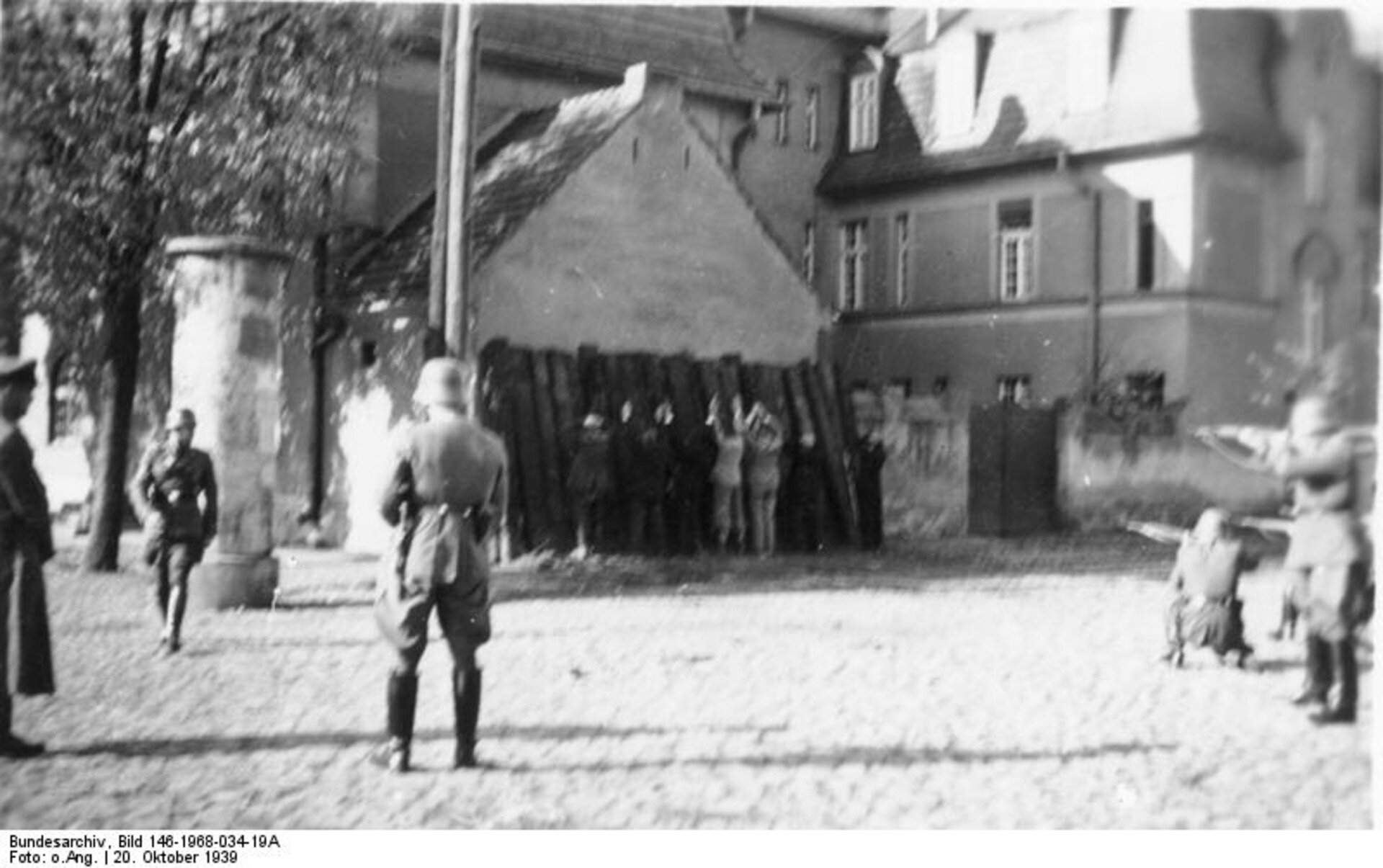Two occupations
how were Polish territories partitioned between the occupants;
what did the organization of territories under German and Russian occupationoccupation look like;
about repressionrepression used by the occupants;
in what way was the extermination and annihilation of the Polish nation reflected;
what was the Deutsche Volkslistethe Deutsche Volksliste and passportizationpassportization;
about the most important places of execution of the Poles at home and abroad;
what was the Katyn massacrethe Katyn massacre and who had done it.
After Polish defence was finished in 1939, the country was divided between the occupants –Third Reich and the Soviet Union. With some slight modifications, the boundary line was carriedd out in accordance to the secret protocol of the Ribbentrov - Molotov Pactthe Ribbentrov - Molotov Pact. The occupants did not intend to respect Polish administration and any manifestations of Polishness in any way. From the very first days they started mass terror towards the Poles, in particular towards those of Jewish ancestry (occupationoccupation German), sending them to concentration camps, deporting into their countries for forced laborforced labor or exterminating. The elites of the country and educated people (politicians, senior military men, teachers, priests) had especially hard fate, as they were usually murdered quickly (e.g. the death of Cracow's professors). Pawiak prison and Palmiry and Katyn, where lots of executions of Polish intellectual elite were held, have become the symbols of Polish martyrdom.
The society was subject to the processes of germanizationgermanization i russification, eliminating any manifestations of Polish culture and science. Polish press was replaced by the one published and controlled by the occupant. Industry plants, bigger estates, museums and art collections were overtaken and nationalizednationalized. Rural popultion was subject to compulsory obligation to deliver supplies for the army, called quotas. Factories were transformed to produce goods for the needs of war and plundering exploitation of natural resources started.
Find out more about the activities of the occupants on Polish territories. What was their long‑term aim?
What information about the Katyn massacre can be read from the above poster?

One of the forms of German repressions were roundups. What happened to their victims?
The photography documents one of the deportation actions, during which the local population does not resist. Using various sources, find out whether the displaced population always passively yielded to the will of the occupier.

Connect the terms related to German occupation and their definitions.
nationalistic and racist German political concept assuming and justifying Germany's territorial expansion in order to acquire the necessary space to live., the element of German occupant policy, aimed at denationalization of conquered nations, territorial entity which was civilly and militarily governed by Nazi Germany, German nationality list divided into 4 categories meaning the degree of German origin., colloqiual term for capturing random cities inhabitants by the Germans during World War II, Polish press published under control of the occupant in place of Polish titles that were liquidated. It praised the occupant's policy and its achievements., German, Nazi youth organization of a paramilitary nature., term describing illegal classes and lectures organized outside schools during the annexation or occupation period
| General Government | |
| Germanization | |
| Lebensraum | |
| Deutsche Volksliste | |
| "Reptile" press | |
| Hitlerjugend | |
| Roundup | |
| Underground education |
Keywords
occupation, the Katyn massacre, underground education, germanization, lebensraum, germanization
Glossary
Pakt Ribbentrop‑Mołotow - porozumienie zawarte między ZSRR i III Rzeszą 23 sierpnia 1939 r., jego tajny protokół przewidywał m.in. podział ziem polskich.
Okupacja – czasowe zajęcie jakiegoś terenu (np. państwa) przez wrogie siły i wprowadzenie tam swojej władzy.
Generalne Gubernatorstwo – utworzone na części ziem polskich, nie wcielonych do III Rzeszy jednostka terytorialna nad którą władzę cywilną i wojskową sprawowały hitlerowskie Niemcy.
Germanizacja – element polityki niemieckiego okupanta, którego celem było wynarodowienie podbitych narodów. Proces ten polegał na przyswajaniu (często pod przymusem) języka i kultury niemieckiej.
Roboty przymusowe – prace wykonywane przez pracowników wbrew swojej woli, za którą nie otrzymują oni wynagrodzenia lub było ono bardzo niewielkie.
Lebensraum – dosłownie przestrzeń życiowa; nacjonalistyczna i rasistowska niemiecka koncepcja polityczna zakładająca i usprawiedliwiająca ekspansję terytorialną Niemiec dla zdobycia niezbędnej przestrzeni do życia.
Deutsche Volksliste – niemiecka lista narodowościowa podzielona na 4 kategorie oznaczające stopień pochodzenia niemieckiego. Osoby wpisane na Volkslistę, w zależności od kategorii, miały pewne przywileje w porównaniu z ludnością polską.
Prasa gadzinowa – polskojęzyczna prasa wydawana pod kontrolą okupanta w miejsce zlikwidowanych polskich tytułów. Wychwalała politykę okupanta i jego dokonania.
Represje – niesprawiedliwe kary nakładane przez państwo wobec obywateli lub prześladowania w formie odwetu na jakiejś grupie.
Prześladowania – celowe nękanie, szykanowanie i wyrządzanie krzywdy wybranym osobom lub grupie osób, którego celem jest ich upokorzenie lub wyniszczenie.
Hitlerjugend – niemiecka, nazistowska organizacja młodzieżowa o charakterze paramilitarnym mająca służyć szkoleniu i rekrutowaniu przyszłych członków bojówek Oddziałów Szturmowych (SA).
Łapanka – potoczne określenie dla zatrzymań przypadkowych mieszkańców miast przez Niemców w czasie II wojny światowej w celu ich przesiedlenie, wysłania na roboty przymusowe lub uwięzienia.
Tajne komplety – określenie nielegalnych zajęć i wykładów organizowanych poza szkołami w okresie zaborów lub okupacji. Najczęściej odbywało się w prywatnych domach.
Deportacja – przymusowe przesiedlenie (wywózka), najczęściej do odległego miejsca, połączone z ograniczeniem wolności.
Propaganda – celowe działania, które mają doprowadzić do określonych zachować i poglądów. Służy ona do upowszechnienia dogodnych informacji dla nadawcy. W języku potocznym synonim kłamstwa i manipulacji.
Paszportyzacja – obowiązek uzyskania paszportu (dowodu osobistego) przez każdego mieszkańca okupowanych terenów, który ukończył 16 lat.
Nacjonalizacja – inaczej upaństwowienie, przejęcie przez państwo majątków, przedsiębiorstw i kapitału prywatnego.
Zbrodnia katyńska – zbrodnia popełniona przez policję polityczną Związku Radzieckiego na Polakach wiosną 1940 roku. Wzięci do niewoli Polacy (ponad 21 tys. ludzi) uznani za „wrogów władzy sowieckiej” zostali zamordowani strzałem w tył głowy. Jednym z miejsc mordu był Katyń. Przez 50 lat (1940‑1990) władze ZSRR zaprzeczały swojej odpowiedzialności za ten czyn.

